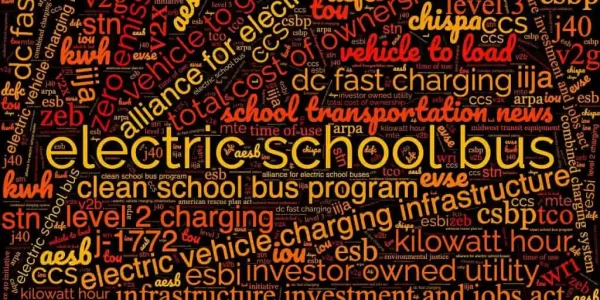Electric School Bus Glossary

As we all work to electrify school buses it can be challenging to keep up with all of the acronyms and terms that get thrown around. From Kilowatt to V2G here is a start of a resource to help you navigate this transition.
Glossary of Acronyms
ARPA: American Rescue Plan Act of 2021. Federal stimulus package that has included funding for ESB and charging infrastructure in districts hit hard by Covid.
AESB: Alliance for Electric School Buses. Nationwide coalition of 20+ not for profit organizations (including this newsletter) that advocate for ESB’s, with emphasis on equity. Convened by Chispa, below, governed by a steering committee.
CSBP: Clean School Bus Program administered by the Environmental Protection Agency (EPA). 2.5 billion for ESB’s over five years; additional 2.5 billion for alternative fuels including electric. Priority to rural, low income, Tribal schools, etc. Nationwide solicitations they state will start in April 2022 (not going through state agencies).
Chispa: Arm of the League of Conservation Voters. Long time leader of ESB advocacy; convenes the Alliance for Electric School Buses, above. Not an acronym, means “spark” in Spanish.
ESB: electric school bus. A more specific term than EV bus, which could also refer to electric public transit buses. ESB’s have vehicle to grid (V2G) potential since most operate just 180 days/year, 5.5 hours average/day, unlike public transit buses, which run much longer hours and are not generally seen as V2G resources.
ESBI: Electric School Bus Initiative housed at World Resources Institute. Leads and funds key ESB advocacy and market acceleration work. Does not fund the purchase of ESB’s (for aid in ESB purchases, see Clean School Bus Program above).
EVSE: electric vehicle charging infrastructure. The hardest part of electrifying a fleet, by far.

Charging depot in the transportation yard of Stockton Unified School District (SUSD) in California. ZEV stands for Zero Emissions Vehicle. The parking deck roof to left has solar panels that help to power the maintenance and operations yard. Photo by Gilbert Blue Feather Rosas, Energy Education Specialist at SUSD.
IIJA: Infrastructure Investment and Jobs Act, passed November 2021, also known as the Bipartisan Infrastructure Package. Includes 5 billion for the Clean School Bus Program, at least 2.5 billion specifically for ESB’s.
IOU: investor owned utility. Examples: XCEL and Florida Power and Light. IOU’s have been second only to Volkswagen Mitigation as funders of ESB’s so far. Many are interested in ESB’s for their vehicle to grid potential (see V2G below).
J40: Justice 40 Initiative. Nationwide effort to direct minimum 40% of federal climate investments to benefit frontline/environmental justice (EJ) communities. The CSBP’s priorities reflect this initiative.
kWh: kilowatt hour, unit of fuel, analogous to a gallon of diesel fuel. If a bus driver uses 1.3 kWh’s per mile (a light foot helps) they should achieve the ESB’s advertised range. If they use less than kWh’s/mile they may get better range, depending on terrain and any heating or cooling of the bus.
L2: Level 2 chargingAC charging from 3kw-19kw charging speeds. Can provide power to fully recharge a school bus overnight, or top it off during midday.
STN: School Transportation News, covers all things school bus, including electric. Does industry conferences as well as news and podcasts. Don’t call it Student Transportation News, like I did one time. My face was so red when Ryan nicely called this error to my attention.
WASBE: Women Accelerating School Bus Electrification. I’m a cofounder of WASBE, which holds quarterly education/networking forums, with Malinda Sandhu of Lion Electric and Susan Mudd of the Environmental Law and Policy Center. We encourage conference and webinar panels to include both women and people of color (an all-male panel is a manel, and an all white panel is a whanel). WASBE’s next forum is May 19th.

WASBE is Women Accelerating School Bus Electrification. We have an emphasis on gender and racial equity. We are maybe not all as young as this graphic suggests (at least I am not).
WRI: World Resources Institute. Global foundation/research center with much reach and influence. See their Electric School Bus Initiative above.
TCO: total cost of ownership of an electric bus. TCO analysis balances high purchase cost against the fuel and maintenance savings that accrue over the lifetime of the bus. Several organizations have TCO tools that fleets can use to consider their decisions. Note that electricity prices vary by region, yet are less volatile overall than diesel prices.
TOU: time of use electricity rates. Utilities use rate schedules to balance their loads. Note: utility demand charges, comparable to speeding tickets, tend to be more costly than TOU charges.
V2G: vehicle to grid, an emerging technology that would have ESB’s (preferably fleets of them) discharge energy from their battery packs into the electric grid at certain needed times. V2G can generate revenue to a district; one vendor suggested about $6,000/year. V2B is vehicle to building energy transfer. V2X is a general term for Vehicle to Load (could be a building or the grid).